BIND 9 Security
Welcome
Welcome to part three of our BIND 9 security webinar series
In this Webinar
- The Berkeley Packet Filter
- eBPF Architecture
- Instrumenting the Linux Network Stack
- Instrumenting BIND 9
- Packet Filtering with eBPF
- Hands-On lab
The Berkeley Packet Filter
What is BPF/eBPF?
- eBPF is the extended Berkeley Packet Filter infrastructure inside the Linux kernel
- eBPF is a further development of the Berkeley Packet Filter technology https://en.wikipedia.org/wiki/Berkeley_Packet_Filter
The eBPF idea
- eBPF allows the administrator to execute sandbox programs inside
the operating system kernel
- eBPF is used to extend the capabilities of the kernel safely, securely and efficiently without modifying the kernel source code or loading kernel modules
- eBPF can monitor and manipulate network packets as well as other data inside Linux kernel
- eBPF programs are not kernel modules, you don't need to be a
Kernel developer to work with eBPF
- but some C programming knowledge is helpful
eBPF
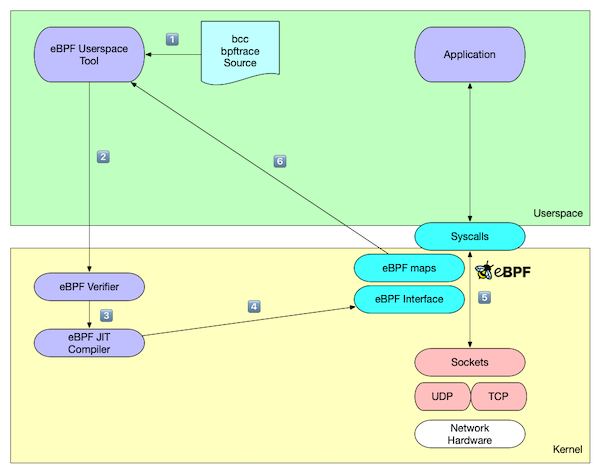
eBPF use cases
- Use cases for eBPF
- Network security (advanced firewall functions)
- Host security
- Forensics
- Fault diagnosis
- Performance measurements
- eBPF is available on modern Linux systems (Kernel 3.18+) and is currently being ported to the Windows operating systems ported by Microsoft
Origins of BPF
- The original BSD Packet Filter (BPF) has been designed by Steven
McCanne and Van Jacobson at Lawrence Berkeley Laboratory
(https://www.tcpdump.org/papers/bpf-usenix93.pdf)
- BPF has been ported to almost all Unix/Linux and some non-Unix operating systems
- BPF is the base technology for some well known network sniffing
tools such as
tcpdumpand Wireshark
BPF operation using tcpdump as an example
- When using a BPF-enabled tool, the filter code is compiled into
bytecode for the BPF in-kernel VM and loaded into the kernel
- The operating system kernel will execute the filter program for every network packet that traverses the network stack
- Only packets that match the filter expression will be forwarded
to the userspace tool,
tcpdumpin this example - BPF helps limiting the amount of data that needs to be sent between kernel and user space
BPF operation using tcpdump as an example
tcpdump can be instructed to emit the source code for a tcpdump filter expression
# tcpdump -d port 53 and host 1.1.1.1 Warning: assuming Ethernet (000) ldh [12] (001) jeq #0x86dd jt 19 jf 2 (002) jeq #0x800 jt 3 jf 19 (003) ldb [23] (004) jeq #0x84 jt 7 jf 5 (005) jeq #0x6 jt 7 jf 6 (006) jeq #0x11 jt 7 jf 19 (007) ldh [20] (008) jset #0x1fff jt 19 jf 9 (009) ldxb 4*([14]&0xf) (010) ldh [x + 14] (011) jeq #0x35 jt 14 jf 12 (012) ldh [x + 16] (013) jeq #0x35 jt 14 jf 19 (014) ld [26] (015) jeq #0x1010101 jt 18 jf 16 (016) ld [30] (017) jeq #0x1010101 jt 18 jf 19 (018) ret #262144 (019) ret #0
eBPF vs. BPF
- While BPF (or now called cBPF = classic BPF) filters network
packets inside the operating system kernel, eBPF does also filter
on
- Kernel systemcalls
- Kernel tracepoints
- Kernel functions
- Userspace tracepoints
- Userspace functions
eBPF and the Linux kernel
- The basic eBPF was introduced into the Linux kernel in
version 3.18
- since then, most new kernel release implemented new eBPF functions
- Linux distributions might have backported eBPF functions into older LTS kernel (Red Hat/Canonical/Suse)
- Overview of eBPF functions by Linux kernel version: https://github.com/iovisor/bcc/blob/master/docs/kernel-versions.md
The eBPF Architecture
The eBPF VM
- eBPF programs are compiled for a virtual CPU
- The code is loaded and verified in the Linux kernel
- On main architectures, the eBPF code is re-compiled into native code (Just in time compiler)
XDP - express data path
- The express data path (XDP) inside the Linux-Kernel is an
infrastructure to gain low level control over network traffic
- side-stepping the normal kernel network stack flow
- eBPF programs can be loaded into the eXpress Data Path (XDP)
XDP / eBPF hardware offloading
- XDP eBPF can be loaded into different level of the Linux kernel
network stack
- Offload XDP: directly into the network hardware (ASIC/FPGA, needs support by the network hardware, for example Netronome NIC)
- Native XDP: into the network driver (low level Linux kernel code, requires support by the driver)
- Generic XDP: into the Linux kernel network stack (less performance, but universally available)
XDP / eBPF execution environments
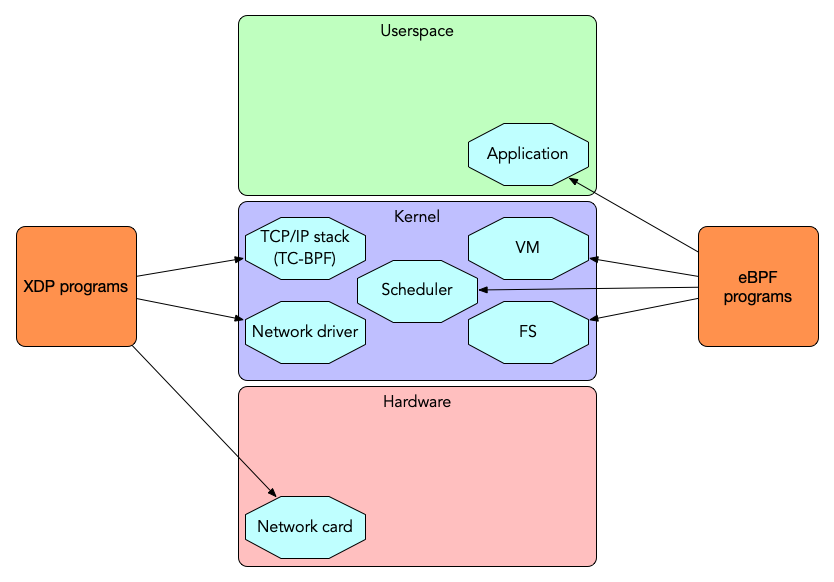
XDP functions
- XDP programs can
- read network packets and collect statistics
- modify the content of network packets
- drop selected traffic (firewall)
- redirect packets to the same or other network interfaces (switching/routing)
- pass the network packet to the Linux TCP/IP stack for normal processing
XDP vs DDoS attack
- XDP can discard unwanted traffic very early in the network stack, defending against DDoS attacks
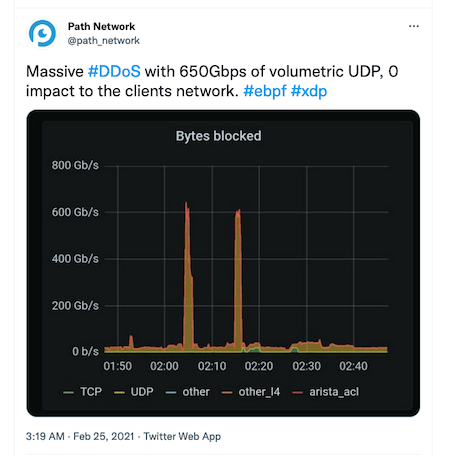
eBPF/XDP support in DNS software
- DNSdist (see Webinar Practical BIND 9 Management - Session 3: Load-balancing with dnsdist) can directly rate limit or block DNS traffic through eBPF and XDP
- The Knot resolver (since version 5.2.0) can bypass the Linux TCP/IP stack and send DNS traffic direct to the user space process (https://knot-resolver.readthedocs.io/en/stable/daemon-bindings-net_xdpsrv.html)
Using eBPF
eBPF tooling
- eBPF programs can be written in many ways
- Low level eBPF assembly code
- High Level compiler (using LLVM): C / GO / Rust / Lua / Python …
- Special "scripting" languages:
bpftrace
BCC
- BCC is the BPF compiler collection
- Website https://github.com/iovisor/bcc
- BCC compiles C or Python code into eBPF programs and loads them into the Linux kernel
BCC tools
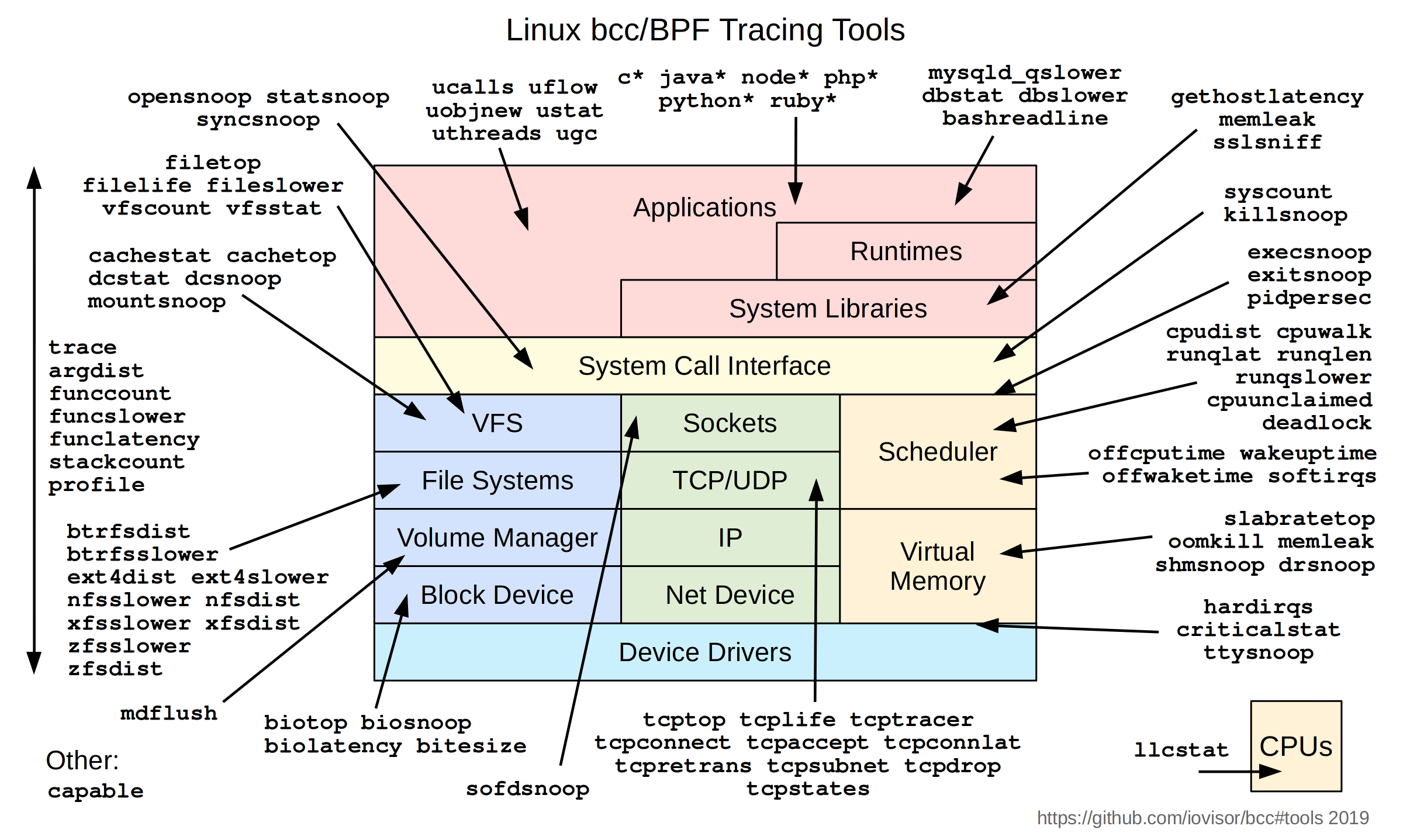
BCC Tool examples (1/2)
- Count syscalls from the BIND 9 process with
syscount
# syscount-bpfcc -p `pgrep named` -i 10 Tracing syscalls, printing top 10... Ctrl+C to quit. [07:34:19] SYSCALL COUNT futex 547 getpid 121 sendto 113 read 56 write 31 epoll_wait 31 openat 23 close 20 epoll_ctl 20 recvmsg 20
BCC Tool examples (2/2)
- Tracing Linux capability checks
# capable-bpfcc | grep named 07:36:17 0 29378 (named) 24 CAP_SYS_RESOURCE 1 07:36:17 0 29378 (named) 24 CAP_SYS_RESOURCE 1 07:36:17 0 29378 (named) 12 CAP_NET_ADMIN 1 07:36:17 0 29378 (named) 21 CAP_SYS_ADMIN 1 07:36:17 0 29378 named 6 CAP_SETGID 1 07:36:17 0 29378 named 6 CAP_SETGID 1 07:36:17 0 29378 named 7 CAP_SETUID 1 07:36:17 109 29378 named 24 CAP_SYS_RESOURCE 1
bpftrace
bpftraceis a little language similar toawkordtrace- Website https://bpftrace.org
bpftraceprograms subscribe to eBPF probes and executes a function whenever an event occurs (systemcall, function-call)bpftracecomes with many helper functions to handle eBPF data structuresbpftraceallows one to write eBPF programs in a more concise way compared to BCC
Instrumenting the Linux Network Stack
BCC and bpftrace tools
- Literally hundreds of little eBPF programs exists to look deep into
the Linux network stack
- The BCC example tools
- The
bpftraceexamples - Examples from eBPF books
gethostlatency
- The BCC tool
gethostlatencymeasures the latency of client DNS name resolution through function calls such asgetaddrinfoorgethostbyname
# gethostlatency-bpfcc TIME PID COMM LATms HOST 10:21:58 19183 ping 143.22 example.org 10:22:18 19184 ssh 0.03 host.example.de 10:22:18 19184 ssh 60.59 host.example.de 10:22:35 19185 ping 23.44 isc.org 10:22:49 19186 ping 4459.72 yahoo.co.kr
netqtop
netqtop- Summarize PPS, BPS, average size of packets and packet counts ordered by packet sizes on each queue of a network interface.
# netqtop-bpfcc -n eth0 -i 10 Mon Nov 15 07:43:29 2021 TX QueueID avg_size [0, 64) [64, 512) [512, 2K) [2K, 16K) [16K, 64K) 0 297.82 2 48 1 4 0 Total 297.82 2 48 1 4 0 RX QueueID avg_size [0, 64) [64, 512) [512, 2K) [2K, 16K) [16K, 64K) 0 70.95 43 34 0 0 0 Total 70.95 43 34 0 0 0 -----------------------------------------------------------------------------
tcptracer
- Tracing TCP connections showing source and destination addresses and ports and the TCP state (accept, connect, close)
# tcptracer-bpfcc -p $(pgrep named) Tracing TCP established connections. Ctrl-C to end. T PID COMM IP SADDR DADDR SPORT DPORT C 29404 isc-net-0000 4 127.0.0.1 127.0.0.1 41555 953 A 29378 isc-socket-0 4 127.0.0.1 127.0.0.1 953 41555 X 29404 isc-socket-0 4 127.0.0.1 127.0.0.1 41555 953 X 29378 isc-socket-0 4 127.0.0.1 127.0.0.1 953 41555 C 29378 isc-net-0000 4 46.101.109.138 192.33.4.12 43555 53 C 29378 isc-net-0000 4 46.101.109.138 192.33.4.12 33751 53 X 29378 isc-socket-0 4 46.101.109.138 192.33.4.12 43555 53 X 29378 isc-socket-0 4 46.101.109.138 192.33.4.12 33751 53 C 29378 isc-net-0000 4 46.101.109.138 193.0.14.129 38145 53 C 29378 isc-net-0000 4 46.101.109.138 192.33.14.30 40905 53 X 29378 isc-socket-0 4 46.101.109.138 193.0.14.129 38145 53 X 29378 isc-socket-0 4 46.101.109.138 192.33.14.30 40905 53
tcpconnlat
- Display the connection latency for outgoing TCP based DNS queries
from a BIND 9 resolver (in this example a query for
microsoft.com txt, which is too large for 1232 byte UDP)isc-net-0000is the internal name of a BIND 9 thread
# tcpconnlat-bpfcc PID COMM IP SADDR DADDR DPORT LAT(ms) 29378 isc-net-0000 4 46.101.109.138 193.0.14.129 53 37.50 29378 isc-net-0000 4 46.101.109.138 192.52.178.30 53 14.01 29378 isc-net-0000 4 46.101.109.138 199.9.14.201 53 8.48 29378 isc-net-0000 4 46.101.109.138 192.42.93.30 53 1.90 29378 isc-net-0000 4 46.101.109.138 40.90.4.205 53 14.27 29378 isc-net-0000 4 46.101.109.138 199.254.48.1 53 19.21 29378 isc-net-0000 4 46.101.109.138 192.48.79.30 53 7.66 29378 isc-net-0000 4 46.101.109.138 192.41.162.30 53 7.97 29396 isc-net-0000 4 127.0.0.1 127.0.0.1 53 0.06
udplife
- A
bpftracescript to trace UDP session lifespans (DNS round trip time) with connection detail (by Brendan Gregg, see link collection)
# udplife.bt Attaching 8 probes... PID COMM LADDR LPORT RADDR RPORT TX_B RX_B MS 29378 isc-net-00 46.101.109.138 0 199.19.57.1 16503 48 420 268 29378 isc-net-00 46.101.109.138 0 51.75.79.143 81 49 43 13 29378 isc-net-00 46.101.109.138 0 199.6.1.52 16452 48 408 24 29378 isc-net-00 46.101.109.138 0 199.249.120.1 81 44 10 9 29378 isc-net-00 46.101.109.138 0 199.254.31.1 32891 64 30 273 29378 isc-net-00 46.101.109.138 0 65.22.6.1 32891 64 46 266
Server agnostic DNS augmentation using eBPF
- A master thesis by Tom Carpay (supported by NLnet Labs)
- eBPF Query-Name rewriting
- In-Kernel DNS server agnostic response rate limiting (RRL)
- https://www.nlnetlabs.nl/downloads/publications/DNS-augmentation-with-eBPF.pdf
Instrumenting BIND 9
Use case -> Forward logging
- A BIND 9 DNS resolver has forward zones configured:
zone "dnslab.org" {
type forward;
forwarders { 1.1.1.1; 8.8.8.8; };
};
- The BIND 9 logging subsystem, while very powerful, does not support the logging of forwarding decisions
- Goal: Create a
bpftracescript that writes out BIND 9 forwarding decisions
Step 1 - Use the force source
- The BIND 9 source code is public, available on the ISC gitlab service https://gitlab.isc.org
- A search through the source for forwarding finds the function
dns_fwdtable_findin/lib/dns/forward.c. This sounds promising:
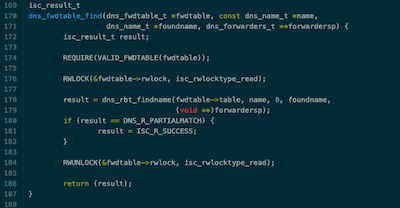
Step 2 - A proof of concept test
- The function
dns_fwdtable_findtakes a domain name and returns0if the name must be resolved through forwarding, and a value greater than 0 if not- A quick
bpftraceone-liner will validate that this indeed works:
- A quick
bpftrace -e 'uretprobe:/lib/x86_64-linux-gnu/libdns-9.16.22-Debian.so:dns_fwdtable_find { print(retval) }'
Step 2 - A proof of concept test
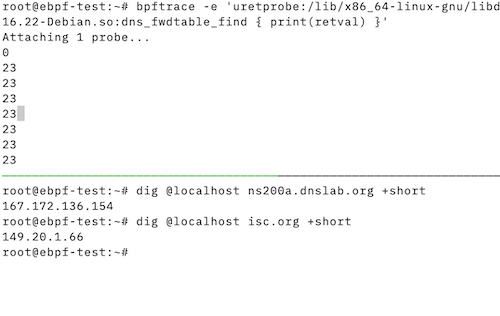
Step 3 - Planning the probe script
- Now we are certain that we have a function to work with, we write a
bpftracescript - The script will
- Store the domain name requested from
dns_fwdtable_findwhen the function is called - Check the return code (
retval) of the function when it returns, and print the domain name when the return value is zero (0), do nothing otherwise
- Store the domain name requested from
Challenge - Wrangling with structs
- The domain name to check for forwarding is given to the function as
a struct of type
dns_name_t- It's not a simple pointer to a string that we can print
- A search through the ISC BIND 9 source code documentation reveals
the structure of
dns_name_t. The 2nd field isunsigned char * ndata, which looks like the domain name
Challenge - Wrangling with structs
- The definition of
dns_name_tcan be found inlib/dns/include/dns/name.h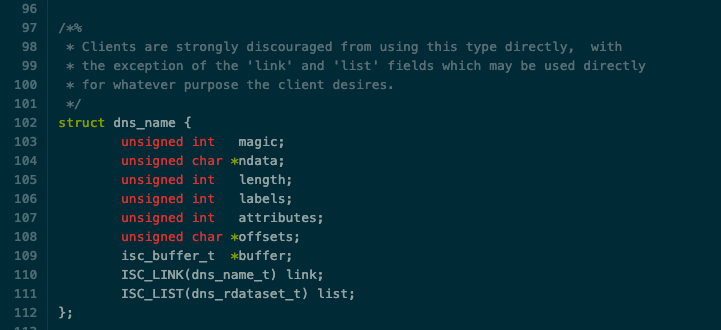
Challenge - Wrangling with structs
bpftraceuses a syntax similar to the C programming language, we can import the struct from the BIND 9 source code into the script- we don't need the linked list and the
isc_buffer_tfields for our script, and these are not native types, so we comment these lines out
- we don't need the linked list and the
#!/usr/bin/bpftrace
struct dns_name {
unsigned int magic;
unsigned char *ndata;
unsigned int length;
unsigned int labels;
unsigned int attributes;
unsigned char *offsets;
// isc_buffer_t *buffer;
// ISC_LINK(dns_name_t) link;
// ISC_LIST(dns_rdataset_t) list;
};
[...]
Printing a message at probe start
- The
BEGINpseudo-probe fires at the start of the script and prints a message, informing the user that the script has been started
[...]
BEGIN
{
print("Waiting for forward decision...\n");
}
[...]
Probing the function call
- This probe fires when the function is called
- it's a
uprobe(User-Space probe) - the function to be probed is
dns_fwdtable_findin the dynamic library/lib/x86_64-linux-gnu/libdns-9.16.22-Debian.so - The 2nd argument to the call (
arg1) is cast into astruct dns_name, and then the fieldndatais referenced - This data is stored into the variable
@dns_name[tid]indexed by the thread ID (tid) of the running thread
- it's a
[...]
uprobe:/lib/x86_64-linux-gnu/libdns-9.16.22-Debian.so:dns_fwdtable_find
{
@dns_name[tid] = ((struct dns_name *)arg1)->ndata
}
[...]
Probing the function exit
- The 3rd probe is firing at function exit (
uretprobe- User-space function return probe)- Same library and function as before
- If the return value of the function is zero
0(domain name needs to be forwarded), the stored data in@dns_name[tid]is converted into a string and printed out - The variable
@dns_name[tid]is deleted as it's not needed any longer
uretprobe:/lib/x86_64-linux-gnu/libdns-9.16.22-Debian.so:dns_fwdtable_find
{
if (retval == 0) {
printf("Forwarded domain name: %s\n", str(@dns_name[tid]));
}
delete(@dns_name[tid]);
}
The final script
#!/usr/bin/bpftrace
struct dns_name {
unsigned int magic;
unsigned char *ndata;
unsigned int length;
unsigned int labels;
unsigned int attributes;
unsigned char *offsets;
// isc_buffer_t *buffer;
// ISC_LINK(dns_name_t) link;
// ISC_LIST(dns_rdataset_t) list;
};
BEGIN
{
print("Waiting for forward decision...\n");
}
uprobe:/lib/x86_64-linux-gnu/libdns-9.16.22-Debian.so:dns_fwdtable_find
{
@dns_name[tid] = ((struct dns_name *)arg1)->ndata
}
uretprobe:/lib/x86_64-linux-gnu/libdns-9.16.22-Debian.so:dns_fwdtable_find
{
if (retval == 0) {
printf("Forwarded domain name: %s\n", str(@dns_name[tid]));
}
delete(@dns_name[tid]);
}
The script in operation
- The script fires whenever a domain name is to be forwarded
- In this example, all queries for the domain
dnslab.orgare forwarded, but notietf.org
- In this example, all queries for the domain
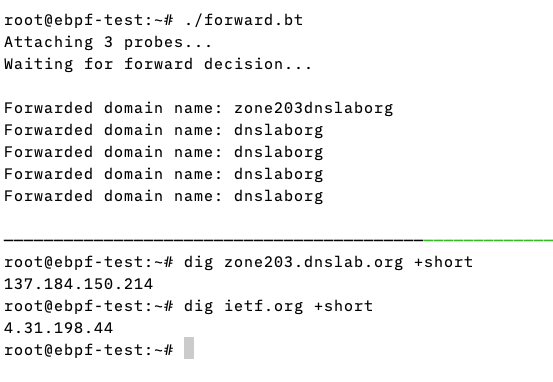
Packet Filtering with eBPF
eBPF as a network firewall
- eBPF can be a very efficient firewall
- It can stop network packets before they enter the Linux TCP/IP stack or the userspace application
- As eBPF runs full programs, the firewall can work on complex
rules
- DNS query names
- DNSSEC data in answers
- Source IP of nameserver
- EDNS data (prioritize DNS messages with DNS cookies)
- …
Example: Block-Non-DNS
- In the Hands-On part of this training, we show a simple eBPF
network filter
- Block all UDP traffic towards a network interface except DNS (Port 53)
- Helps in non-DNS DDoS attacks against an authoritative DNS server
Example: XDP Firewall
- The XDP Firewall is a new project to create a firewall tool
leveraging XDP
- https://github.com/gamemann/XDP-Firewall
- Example rule-set to block all DNS traffic on Port 53
interface = "eth0";
updatetime = 15;
filters = (
{
enabled = true,
action = 0,
udp_enabled = true,
udp_dport = 53
}
);
Literature and Links
Book: Linux Observability with BPF
By David Calavera, Lorenzo Fontana (November 2019)

Book: Systems Performance (2nd ed.)
By Brendan Gregg (December 2020)

Book: BPF Performance Tools
By Brendan Gregg (December 2019)

Links
- For the webinar we have a extensive list of links that can be found at https://webinar.defaultroutes.de/webinar/08-ebpf-links.html
Next webinars
- December 15 - DNS Fragmentation: Real-World measurements, impact and mitigation
Questions and Answers
Hands-On
- We have prepared a VM machine for every participant
- Find the instructions at https://webinar.defaultroutes.de/webinar/08-ebpf-workshop.html